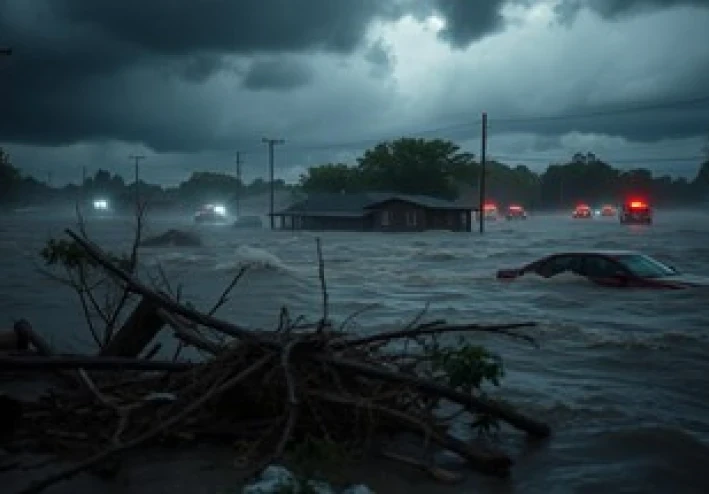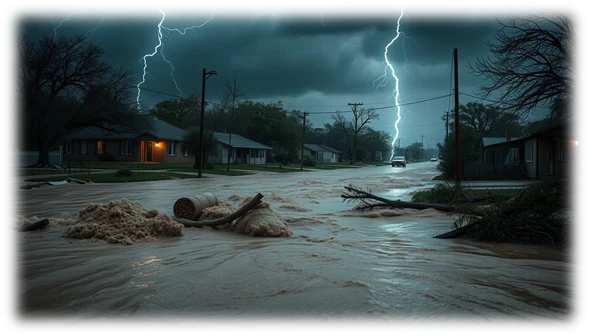
Kerr County Underwater: Inside the Deadliest Inland Flood in Texas 2025
Kerr County Underwater: Inside the Deadliest Inland Flood in Texas 2025

Introduction
The Texas floods of 2025 reshaped Kerr County forever, marking it as the heart of America’s most devastating inland disaster.
This piece takes you through the storm's brutal path from the roaring flash floods and feme’s swift response to the personal stories of heartbreak and resilience.
The narrative captures the tragic intersection of climate extremes infrastructure failure and a community caught off guard.
I still remember reading about it and feeling an ache I couldn't shake. What does it take for a town to rise again after such ruin?
The Storm That Changed Everything
What made the Texas floods in 2025 so destructive?
It wasn’t just heavy rain. The skies opened with a vengeance unleashing a deluge that struck Kerr County like a sudden punch in the gut.
While storms aren’t new to Texas this one came with a twist-a slow-moving weather system already
fueled by soaked ground and blocked drainage turned a bad situation into a perfect storm.
You could almost hear the land begging for a break. But the water didn’t stop.
It filled streets homes and hearts with dread.

A History Drenched in Water
Texas has endured its share of floods, but 2025 drew a new terrifying line in the sand.
The echoes of Hurricane Harvey were still fresh when Kerr County found itself drowning under record-breaking rainfall.
This wasn’t just a weather event-it was the kind of disaster that etches itself into state memory.
FEMA's early involvement helped stabilize the chaos, yet the sheer scale of destruction demanded more than just immediate relief.
It required a rethinking of what “preparedness” really means.
Seconds to Spare: When the Flood Hit
It all began with an eerie forecast. Meteorologists had spotted a looming storm, but no one fully understood what was coming.
In a matter of hours, rainfall escalated from alarming to catastrophic.
Early warnings were issued-but they weren’t enough.
Many residents barely had time to grab essentials before the water burst through streets like a beast unleashed.
Whole neighborhoods vanished beneath the flood.
Three Days of Horror: The 72-Hour Catastrophe
The flood didn’t pass in a day. For three relentless days, the rain poured and the water climbed.
Homes were swallowed power grids collapsed and roads turned to rivers.
The devastation wasn’t just physical. It clawed at people’s spirits.
By the end of the third day Kerr County was a ghost of its former self-mud-covered silent, stunned.
There was a line in a survivor’s journal that stuck with me: “We heard no thunder
just the sound of everything we loved going under”
The Immediate Human Toll: Lives Lost Families Broken
When the waters surged through Kerr County, they didn’t just take buildings-they took people.
The flood triggered a full-blown humanitarian crisis, placing the community at the heart of one of the deadliest inland disasters in American memory.

The True Cost in Human Lives
The numbers were staggering. More than a hundred souls gone lost in their homes others while trying to escape.
One location Camp Mystic became a heartbreaking symbol of the tragedy. It was meant to be a place of laughter and summer joy.
Instead it turned into a scene of unimaginable sorrow.
The deaths weren’t just statistics. Each one carried a name a story and a family left behind to pick up the shattered pieces.
Thousands Without Shelter: A Displaced Community
Entire families were forced from their homes with nothing but the clothes they wore.
Thousands fled to emergency shelters scattered across the region seeking dry ground warmth and safety.
It was a wave of displacement so sudden and overwhelming even seasoned responders struggled to keep pace.
Shelters provided food, water, and basic hygiene but they couldn’t restore what was lost.
People slept in cots, whispering prayers and hoping for news about missing loved ones. You could feel the exhaustion hanging in the air like fog.
Broken Roads Collapsed Bridges: Infrastructure in Ruins
As the waters receded, they left behind not peace but wreckage. Roads buckled. Bridges gave out.
Power lines dangled uselessly. Entire neighborhoods had been split in two, not just by water but by the loss of everything that made them home.
Critical services were paralyzed. Rescuers struggled to reach certain areas. Deliveries of aid were delayed.
It became painfully clear that rebuilding would take more than money-it would take time, heart, and willpower.
(And yet people still showed up with shovels, boats and hope.)
Camp Mystic: From Sanctuary to Scene of Tragedy
Camp Mystic, once a haven tucked among Texas hills, became ground zero for heartbreak.
Floodwaters arrived so quickly that neither campers nor staff had time to react. Structures crumbled Escape paths vanished.
The camp became a fight for survival.
Chaos and Rescue
Emergency crews rushed in, but the terrain fought back.
With flooded roads and downed communication getting to the camp felt like threading a needle during a storm. Despite the obstacles, first responders and volunteers battled through.
Lives were saved-but not all.
Stories Etched in Memory
What emerged from Camp Mystic was not just tragedy, but humanity at its best. Counselors carrying children on their backs.
Teenagers helping one another through knee-deep waters. Final phone calls. Last goodbyes. Quiet moments of courage.
These weren’t just anecdotes-they were the backbone of the town’s memory. And they will be remembered long after the floodwaters are gone.
Local Response: When Kerr County Fought Back
In the face of catastrophe, Kerr County’s emergency teams sprang into action.
It wasn’t flawless. It wasn’t fast enough. But it was human-raw and determined, driven by urgency.
The initial protocols, though stretched thin, played a critical role in managing chaos as the flood overtook the county.
First Line of Defense
The moment forecasts turned grim, local emergency managers activated protocols.
Evacuation orders were issued for at-risk zones. Shelters were opened, and volunteers mobilized.
The system worked partially. But the sheer magnitude of the storm outpaced expectations.
Many responders were residents themselves saving strangers by day and checking on their own flooded homes by night.
Resources Pushed to the Brink
Kerr County wasn’t ready for a disaster on this scale-few places could be. Emergency personnel were overwhelmed and equipment was limited.
Trucks were diverted. Communication lines jammed. Helicopters couldn’t land in submerged areas.
It was a battle against not just nature but logistics. One official admitted "We were fighting a flood with garden tools".
It was a raw but honest line that captured how fragile local capacity really was.
When Neighbors Become Heroes
As professional rescue efforts hit barriers, the people stepped in. Farmers with tractors. Fishermen with boats.
Teenagers on makeshift rafts. It was neighbors pulling neighbors from rooftops, strangers feeding strangers.
This grassroots response wasn’t just inspiring-it was essential. Entire communities rallied when official help couldn’t reach them.
There’s something ancient and primal about people forming human chains in the rain defying the current to save someone else. Isn’t that the truest form of strength?
The Power of Coordination
Despite the chaos, coordination among agencies-local, state, and federal- began to take shape.
FEMA worked with local leaders to deploy resources more efficiently. Duplicated efforts were reduced. Rescue routes were optimized.
Temporary communication hubs were created where cell service had vanished.
Every small win counted. It was a messy kind of order-but it worked.
FEMA Steps In: Federal Help on the Ground
FEMA’s arrival marked a turning point. Within hours of the federal disaster declaration, personnel and resources flooded into Kerr County.
They set up recovery centers, distributed aid, and assessed damage.
But this wasn’t a story of smooth efficiency. There were delays. Miscommunications.
Entire neighborhoods went unnoticed at first. Still, the agency’s presence anchored the larger relief effort laying the groundwork for longer-term recovery.
Relief in Real Time: The First Wave of Help
As soon as the skies cleared, the real work began-not with bulldozers but with blankets, bread, and bottled water. Emergency shelters across Kerr County welcomed thousands, offering not just a dry place to sleep but a small breath of dignity amid the chaos.
Shelters and Basic Needs
Makeshift shelters became lifelines. They provided food, water, and medical supplies to families who had lost everything. Volunteers organized supplies into labeled boxes-though sometimes mislabeled, sometimes missing. But it was something.
People helped each other wash mud off their children’s feet. Meals were shared. Blankets were passed from one stranger to another like unspoken hugs.
Healing the Body and the Mind
The flood didn't just damage homes-it hurt people inside and out. Medical teams were deployed to treat injuries, infections and illnesses. Mobile clinics drove through damaged neighborhoods checking on the elderly the stranded the grieving.
More importantly mental health counselors showed up. PTSD anxiety and grief sat silently next to people in shelters and these counselors tried to ease the load. Not all wounds bleed. Some just sit there invisible but sharp.
Financial Aid: Quick but Complicated
FEMA and local agencies began distributing emergency funds. Rent assistance, food vouchers rebuilding stipends-it all started to roll out.
But for many accessing aid felt like navigating a maze.
Forms were confusing. Internet access was patchy. Identification was lost in the flood. Still people persisted.
One woman reportedly filled out the same form three times before it went through- “because giving up wasn't an option” she said.
The Heart of the Effort: Volunteers
If the flood revealed anything, it was this:
Kerr County's spirit could not be drowned.
Volunteer groups arrived in droves—churches student groups veterans and ordinary folks with no official badge just a shovel and a will to help.
They cleared debris delivered meals sat with grieving families.
Their work was messy emotional and sometimes unrecognized But it mattered It still does.
Long-Term Recovery: Rebuilding More Than Roads
Reconstruction didn’t start with bricks-it started with hope.
Roads and bridges were prioritized yes but so were homes and hearts.
Infrastructure Renewal
FEMA-funded projects kicked off to rebuild the literal backbone of Kerr County-roads bridges power lines.
But this time with resilience in mind Higher standards Smarter planning Flood-resistant materials.
Mistakes were made Some plans stalled But the effort was real And visible.
Homes and Housing Stability
Thousands were displaced. Rehousing them wasn’t just about speed-it was about quality.
Temporary shelters transitioned into semi-permanent housing. New building codes were introduced.
Homeowners received grants Renters were offered protection.
It wasn’t perfect. It wasn’t fast But slowly people began turning keys in new doors again.
Economic Support and Emotional Survival
Local businesses reopened with the help of grants and community fundraisers.
Pop-up markets, job fairs and business repair grants brought life back into town squares.
And on another level-less visible but just as real-mental health services expanded.
Community support groups were formed. People met every Thursday to talk not just about recovery but about loss hope and the strange guilt of having survived.
After the Water: Nature’s Scars Revealed
When the floodwaters pulled back they left behind more than mud and memory.
Kerr County’s natural landscape had been shredded. Ecosystems torn Rivers twisted Habitats erased.
A Wounded Environment
Native species were displaced Erosion gnawed at riverbanks. Sediment clogged local waterways choking fish and plant life.
The land looked familiar, but it wasn’t the same. Entire food chains were disrupted like a melody missing half its notes.
It was clear: this wasn’t just a human tragedy. Nature had suffered too-and would need time to heal.
A Changed Watershed A New Reality
The geography had changed Literally Some rivers now flowed differently.
New low-lying areas were formed-future flood risks waiting to happen.
Experts conducted updated hydrological mapping using satellite imagery and data from the 2025 flood.
It revealed uncomfortable truths: flood zones were larger than previously thought.
Entire neighborhoods that had been labeled “safe” were anything but.
The future would require more than rebuilding. It would demand reimagining how Kerr County lives with water.
Lessons Etched in Water: Preparing for What’s Next
The failures of 2025 couldn’t be repeated Warning systems had been too slow.
Communication gaps had cost lives. That reality sparked change.
Tech Meets Readiness
Kerr County began investing in AI-driven weather monitoring drone reconnaissance and faster evacuation alerts.
A smarter system was born out of pain and necessity.
Schools ran drills Families built emergency kits. Even kids knew where the high ground was.
And maybe just maybe that’s how healing begins: not with denial, but with determination.
A Closing Reflection: Kerr County’s New Chapter
The Texas Floods of 2025 nearly broke Kerr County. But it didn’t.
What emerged from the water wasn’t just loss—it was resilience The faces of soaked volunteers.
The whispered prayers in shelters The laughter of children in rebuilt parks.
The pain will echo for years. But so will the courage.
Because after the flood, after the headlines fade, what remains is the people.
Their stories.
Their scars.
And their quiet promise:
“We’re still here.”




































